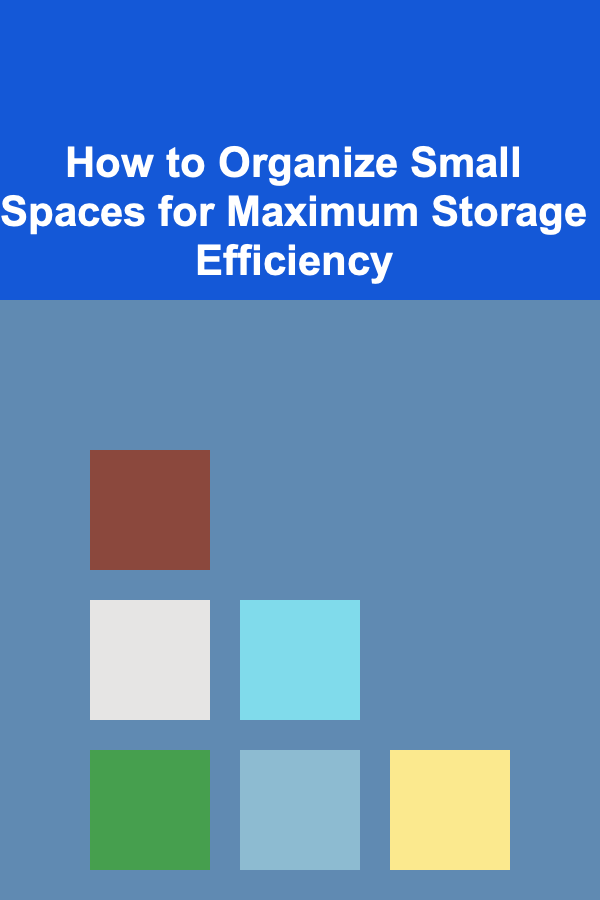
How to Design a Mudroom with Practical Storage Features
ebook include PDF & Audio bundle (Micro Guide)
$12.99$7.99
Limited Time Offer! Order within the next:

The mudroom is often considered the unsung hero of the home, serving as a transition space between the outdoors and the indoors. It's where shoes come off, coats are hung, and bags are dropped. A well-designed mudroom not only enhances the functionality of your home but also contributes to its aesthetic appeal. In this comprehensive guide, we will explore how to design a mudroom with practical storage features that cater to your family's needs and lifestyle.
Understanding the Purpose of a Mudroom
Before diving into the design process, it's essential to understand the primary functions of a mudroom:
1. Transition Space
A mudroom acts as a buffer zone, preventing dirt and debris from entering the main living areas. It provides a dedicated space for items that are often messy or wet.
2. Organizational Hub
This space is ideal for organizing outdoor gear, such as shoes, jackets, backpacks, and sports equipment. By keeping everything in one place, a mudroom promotes efficiency and reduces clutter in other parts of the home.
3. Convenience
Having a designated area for coming and going allows for easier management of daily activities, such as dropping off groceries, handling laundry, or preparing for school and work.
4. Style Statement
Beyond functionality, a mudroom can be a stylish addition to your home. With thoughtful design choices, it can enhance the overall aesthetic of your entryway.
Assessing Your Space
Step 1: Evaluate Available Space
The first step in designing a mudroom is assessing the available space. Consider these factors:
- Dimensions: Measure the length and width of the area designated for the mudroom. This will dictate what storage features and furniture can fit.
- Access Points: Identify access points, such as doors leading to the outside or adjacent rooms. Consider traffic flow and how people will move through the space.
- Lighting: Evaluate natural light sources and plan for adequate lighting fixtures. Bright spaces feel more inviting and functional.
Step 2: Identify Needs
Next, determine the specific needs of your household. Consider the following:
- Family Size: Larger families may require more extensive storage solutions to accommodate everyone's belongings.
- Lifestyle: Do you have pets? Are there children involved in sports? Understanding your lifestyle can help tailor the storage solutions.
- Seasonal Changes: Take note of how seasonal changes affect what you need to store. For example, winter gear may take up more space than summer items.
Step 3: Establish Style Preferences
Determine the style of your mudroom. Consider how it will fit into the overall design of your home. Some common styles include:
- Traditional: Characterized by warm wood tones, classic cabinetry, and decorative moldings.
- Modern: Features sleek lines, minimalistic designs, and contemporary materials.
- Rustic: Utilizes natural materials, such as reclaimed wood and stone, for a cozy, country feel.
- Industrial: Incorporates metal elements, exposed brick, and a utilitarian design.
Essential Storage Features for a Functional Mudroom
Once you have assessed your space and established your needs and preferences, you can begin designing your mudroom with practical storage features. Here are some essential elements to consider:
1. Lockers or Cubby Systems
Lockers or cubbies provide individual spaces for family members to store their belongings. This helps keep items organized and accessible.
Benefits:
- Personalization: Each family member can have their own designated storage space, reducing mix-ups.
- Accessibility: Items stored in lockers are easily reachable, making it convenient for everyone to grab what they need on the go.
Design Tips:
- Choose materials that match your overall decor, such as wood for a traditional look or metal for an industrial feel.
- Consider including hooks or small shelves within each cubby for added organization.
2. Bench Seating
A bench provides a convenient place to sit while putting on or taking off shoes. It can also serve as additional storage if it has built-in compartments.
Benefits:
- Comfort: Offers a comfortable spot for changing shoes, which is especially useful for families with children.
- Storage: Benches with storage under the seat can hold items like shoes, boots, or seasonal gear.
Design Tips:
- Select a durable fabric or material that can withstand wear and tear, particularly if it will be used frequently.
- Consider adding cushions or pillows for extra comfort and visual appeal.
3. Hooks and Racks
Hooks and racks are vital for hanging coats, bags, hats, and other items that would otherwise clutter the floor.
Benefits:
- Space-Saving: Utilizing vertical space keeps floors clear and maximizes storage capacity.
- Easy Access: Hooks make it simple to grab items quickly when heading out.
Design Tips:
- Install hooks at varying heights for different users, ensuring children can reach their items independently.
- Use decorative hooks that match your style, turning practical storage into a design feature.
4. Shelving Units
Open or closed shelving units provide versatile storage for various items, from shoes to baskets filled with smaller items.
Benefits:
- Flexible Storage: Shelves can accommodate a wide range of items, providing flexibility based on your storage needs.
- Display Opportunity: Open shelving allows you to display decorative items or plants, enhancing the aesthetic of the space.
Design Tips:
- Choose adjustable shelving to adapt to changing storage needs over time.
- Incorporate baskets or bins on shelves to keep smaller items organized and concealed.
5. Shoe Storage Solutions
Keeping shoes organized can prevent clutter in your mudroom. There are several options for shoe storage that can be incorporated into your design.
Options:
- Shoe Racks: Simple racks can hold multiple pairs of shoes, keeping them visible and accessible.
- Built-In Cabinets: For a cleaner look, consider built-in cabinets with doors that conceal shoes while still providing easy access.
- Drawer Systems: Drawers specifically designed for shoes can help keep them organized and dust-free.
Design Tips:
- Designate a specific area for shoes, ensuring it's easily accessible to all family members.
- Choose materials that are easy to clean, especially for outdoor shoes that may bring in dirt.
6. Baskets and Bins
Baskets and bins are perfect for storing smaller items like gloves, scarves, or dog leashes. They add an element of texture and can be both functional and decorative.
Benefits:
- Organizational Aid: Keeps smaller items contained and organized, making it easy to find what you need.
- Aesthetic Appeal: Attractive baskets can add to the overall decor of the mudroom.
Design Tips:
- Label baskets for quick identification of contents.
- Choose coordinating colors or materials to create a cohesive look.
7. Specialized Storage for Sports Equipment
If your family is active, consider incorporating specialized storage for sports gear and outdoor equipment.
Solutions:
- Wall-Mounted Racks: Use wall-mounted racks to hang bikes, skateboards, or sports gear, keeping them off the floor and organized.
- Cabinets with Adjustable Shelves: Install cabinets specifically designed for storing larger sports items
Design Tips:
- Ensure that the storage solutions are easily accessible for all family members to encourage organization.
- Consider using clear bins for smaller items to allow visibility.
8. Laundry Features
If your mudroom is adjacent to the laundry room, consider incorporating laundry-related features, such as hampers or drying racks.
Benefits:
- Convenience: Makes it easy to transfer clothes from the mudroom to the laundry room.
- Organization: Keeps dirty clothes separate from clean storage areas.
Design Tips:
- Use hampers with lids to contain odors and maintain a tidy appearance.
- Install foldable drying racks or hooks for hanging damp items.
Designing the Layout
Once you have determined which storage features to incorporate, it's time to design the layout of your mudroom. Here are some tips to achieve an efficient and aesthetically pleasing arrangement:
1. Plan for Traffic Flow
Consider how people will enter and exit the mudroom. Ensure that the layout allows for smooth movement without obstruction. Place the bench and hooks near the entrance for easy access.
2. Create Zones
Divide the mudroom into specific zones based on function. For example:
- Entry Zone: Where people enter and drop off belongings (hooks, benches).
- Storage Zone: Where items are stored away (cubbies, cabinets).
- Laundry Zone: If applicable, where laundry-related tasks are completed (hamper, drying rack).
3. Maximize Vertical Space
Utilize vertical space by installing shelves or cabinets that go up to the ceiling. This approach draws the eye upward, making the space feel larger while providing ample storage.
4. Incorporate Natural Light
If possible, integrate windows or glass doors to bring natural light into the mudroom. Adequate lighting makes the space feel more inviting and functional.
5. Choose Durable Materials
Select materials that are not only stylish but also durable and easy to clean. Mudrooms experience a lot of foot traffic and potential messes, so opt for materials that can withstand wear and tear.
Personalizing Your Mudroom Design
A mudroom doesn't have to be purely functional; it can also reflect your personal style. Here are some ways to personalize your mudroom design:
1. Color Palette
Choose a color palette that complements your home's overall design. Soft, neutral colors can create a calming atmosphere, while bold hues can add personality.
2. Decorative Accents
Incorporate decorative accents such as artwork, mirrors, or decorative storage boxes to create a welcoming atmosphere. Consider displaying family photos or artwork that reflects your style.
3. Textures and Patterns
Mix textures and patterns to add depth to the design. For instance, combine wooden elements with textiles for cushions or rugs to create a warm and inviting space.
4. Seasonal Decor
Incorporate seasonal decor to keep the space feeling fresh throughout the year. Changing decorations based on the season can add personality and warmth.
5. Personal Touches
Add personal touches, such as monogrammed hooks, custom labels for storage bins, or hand-painted signs, to make the space truly yours.
Maintenance and Organization Tips
Once your mudroom is designed and organized, maintaining that order is key to long-term functionality. Here are some maintenance tips:
1. Regular Decluttering
Establish a routine for decluttering the mudroom. Set aside time every few months to review items stored in the space and remove anything that is no longer needed.
2. Encourage Family Participation
Get the entire family involved in keeping the mudroom organized. Make it a habit to return items to their designated spots after use.
3. Seasonal Review
At the beginning of each new season, review the items stored in the mudroom. Swap out seasonal gear and ensure everything is in good condition.
4. Keep Cleaning Supplies Handy
Store cleaning supplies in the mudroom for quick access. Keeping surfaces clean and organized will help maintain the space's aesthetic.
5. Evaluate Storage Solutions
Periodically evaluate whether your current storage solutions continue to meet your needs. As your family grows or changes, you may need to adjust your organization strategy.
Conclusion
Designing a mudroom with practical storage features is essential for creating an organized and functional space that enhances your home. By understanding the purpose of a mudroom, assessing your space, incorporating essential storage elements, and personalizing the design, you can create an area that meets your family's needs while contributing to the overall aesthetic of your home.
Remember that a well-designed mudroom should not only be practical but also inviting, reflecting your unique style and personality. By implementing thoughtful organization strategies and maintaining the space, you can ensure that your mudroom remains a valuable asset in your home for years to come. Embrace the opportunity to create a functional yet beautiful transition space that helps you manage daily life with ease and style.
Reading More From Our Other Websites
- [Weaving Tip 101] How to Create a Multi‑Layered Rug Using the Double‑Weave Method for Added Comfort and Longevity
- [Organization Tip 101] How to Choose the Best Utensil Material for Your Needs
- [Organization Tip 101] How to Embrace Imperfection in Your Organized Space
- [Home Holiday Decoration 101] Best Inspiration for Holiday Home Decor That Reflects Your Style
- [Skydiving Tip 101] From Tandem to Solo: How to Progress Your Skydiving Skills Safely
- [Home Rental Property 101] How to Spotlight Unique Features Like a Man Cave to Make Your Rental Property Stand Out
- [Personal Financial Planning 101] How to Improve Your Credit Score: A Comprehensive Guide
- [Personal Care Tips 101] Creating Ayurvedic Self-Care Rituals for Your Dosha
- [Home Budget 101] How to Create a Home Emergency Fund: Protecting Your Finances as a Homeowner
- [Home Family Activity 101] How to Create Family Traditions Around Holidays and Special Occasions

How to Organize Small Spaces for Maximum Storage Efficiency
Read More
How to Store Die Cuts and Stencils for Easy Access
Read More
How to Use Fabric and Textiles to Add Holiday Spirit to Your Home
Read More
How to Work Remotely While Traveling: A Step-by-Step Guide
Read More
Volleyball Coach Planner: Player Evaluation System
Read More
10 Tips for Speed Sudoku Solving
Read MoreOther Products

How to Organize Small Spaces for Maximum Storage Efficiency
Read More
How to Store Die Cuts and Stencils for Easy Access
Read More
How to Use Fabric and Textiles to Add Holiday Spirit to Your Home
Read More
How to Work Remotely While Traveling: A Step-by-Step Guide
Read More
Volleyball Coach Planner: Player Evaluation System
Read More